I successfully rooted a Florida dogwood (Cornus florida) from a cutting! This is a tree that’s been tricky in the past for me to propagate, and I finally had some success I think is worth sharing.
In this post, I’ll walk you through exactly what worked, step-by-step instructions for how to root flowering dogwood cuttings yourself, and some tips and tools that made all the difference; especially an upgraded rooting hormone that really seemed to help get some roots started.
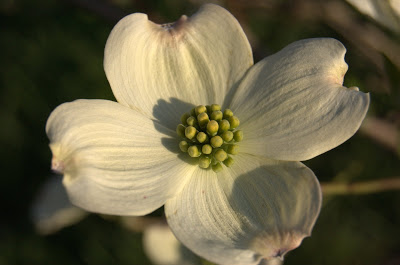
I may earn a small commission if you purchase through some of the links in this post at no extra cost to you. I only recommend products I use and trust!
Why Dogwoods Are Tricky to Root
Red twig dogwoods are pretty easy to root but Florida dogwoods (Cornus florida) are much more difficult. Many of the cultivars you purchase at the nurseries tend to be grafted trees on seed grown root stock. Growing dogwoods from seed is actually a pretty easy process. I’ve tried cuttings before with little success, but this time I made a few changes to my usual approach. In particular:
- Timing: I used greenwood cuttings taken in early summer.
- Medium: I used a sand and coco coir mix for good drainage and moisture retention.
- Rooting Hormone: I switched to a much stronger rooting hormone – more on that below.
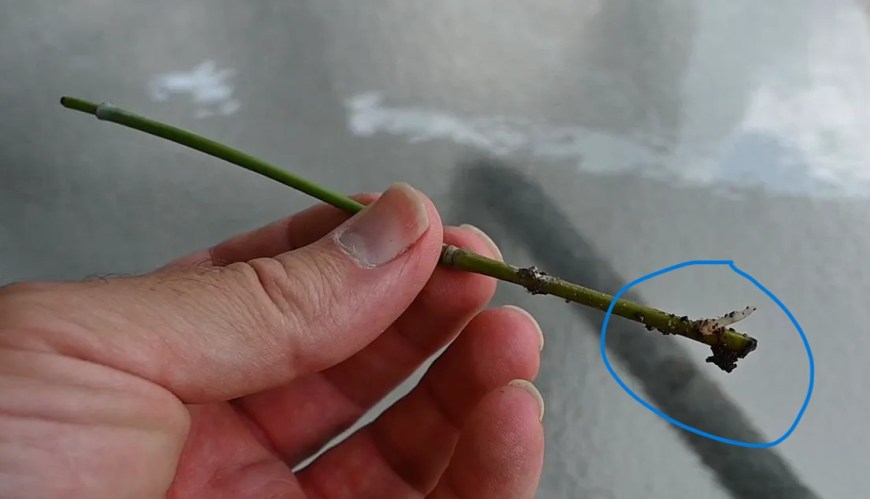
Rooting Hormones: Why I Switched to Hormodin 3
Most gardeners use something like the Garden Safe TakeRoot Rooting Hormone, which contains 0.1% indole-3-butyric acid (IBA). That’s a synthetic plant hormone that helps cuttings grow roots. This concentration is easy to find at your local hardware stores or online.
Florida dogwoods are tougher to root, and that lower concentration just wasn’t working well enough to produce roots.
I upgraded to Hormodin 3, which contains 0.8% IBA – eight times stronger than TakeRoot. TakeRoot is still great for easier to root plants, perennials, shrubs, and some trees but the .1% IBA isn’t enough for some more challenging plants.
Here’s a link to the rooting hormone I used:
When sticking cuttings use a clean jar or container to dip the cuttings in and don’t dip directly into the original Hormodin jar to avoid possible contamination.
Materials I Used
- Pruners (clean and sharp)
- Yogurt cups (with holes punched for drainage. You can use any plastic container that will hold a rooting medium and water.)
- Rooting medium: mix of sand and coco coir
- Hormodin 3 rooting hormone
- Paintbrush handle or dibber (to pre-make holes)
- Water jar (to hold cuttings while prepping)
Step-by-Step: How to Root Dogwood Cuttings
Here’s exactly how I rooted my Cornus florida cuttings.
1. Pick the Right Time and Material
- Take greenwood cuttings in early morning during early to mid-summer.
- Choose stems that are 4–5″ long with at least three leaf nodes.
2. Prepare the Cuttings
- Cut just below a leaf node.
- Remove all but the top leaf.
- Optionally, wound the base by gently scraping the bark to expose the cambium layer—this can increase root formation.
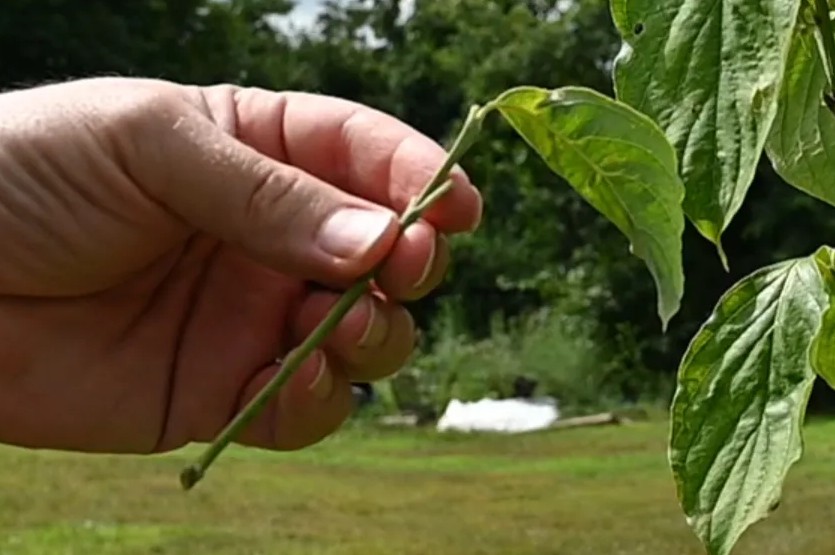
3. Dip in Rooting Hormone
- Dip the base in rooting hormone and tap off any excess.
- Pre-make a hole in your rooting medium to avoid wiping off the hormone when planting. I used a kids paint brush handle to do this. A pencil, pen, or even just a stick and work for a dibber.
4. Plant in Medium
- Stick the cuttings into a container filled with pre-moistened sand and coco coir mix.
- Firm the medium around the base so it has good contact.
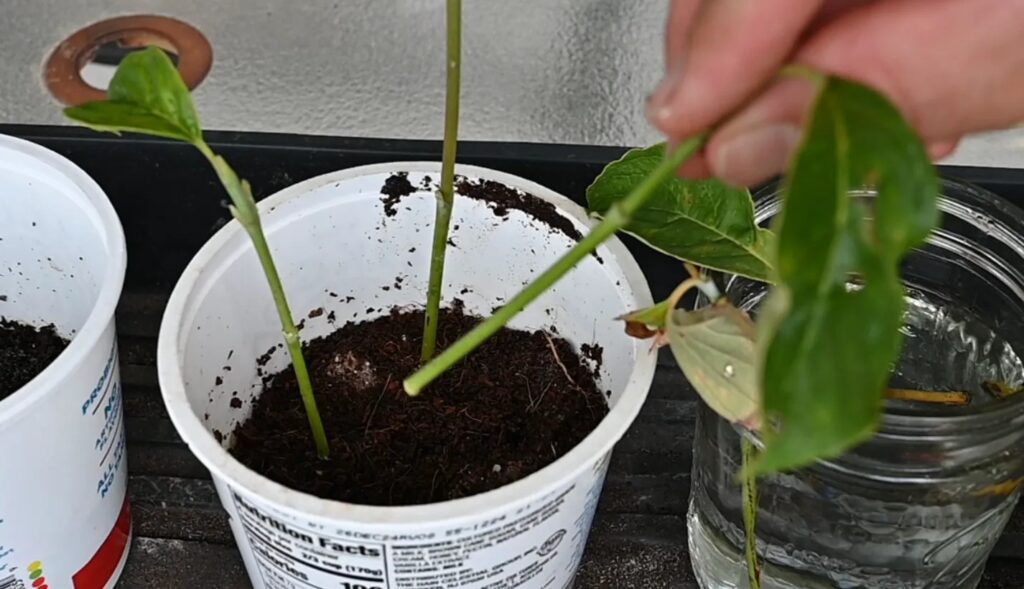
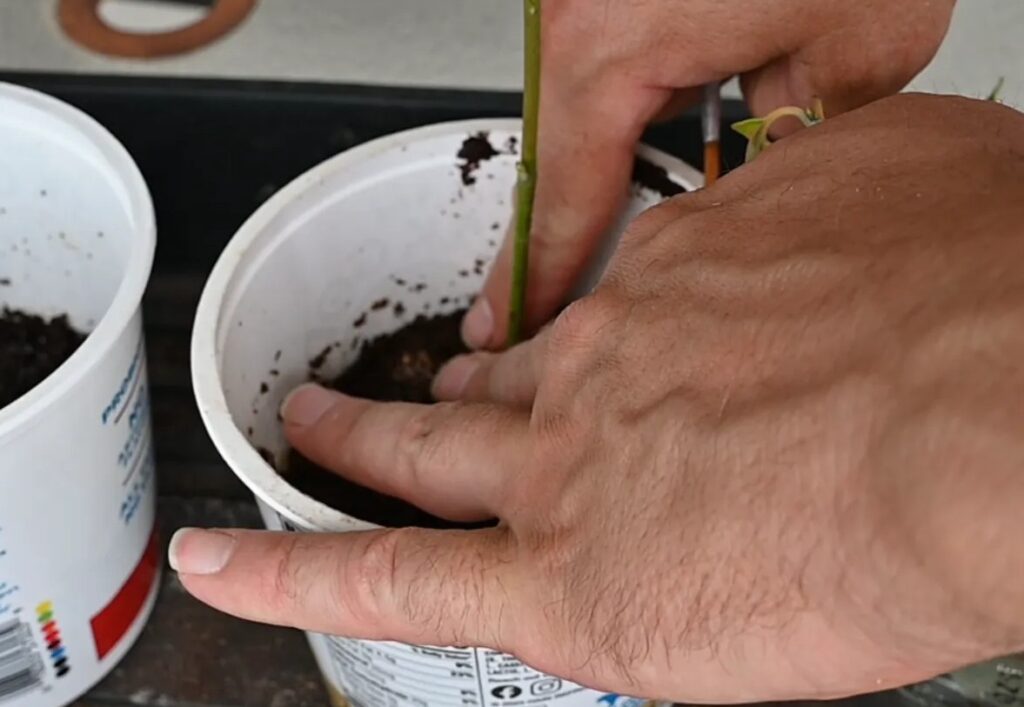
5. Provide the Right Environment
- Keep the cuttings out of direct sun – you can use shade or grow lights.
- Mist regularly, especially during hot weather.
- Maintain high humidity around the cuttings. You can cover the cuttings with a tented plastic bag or use regular misting to keep the humidity high.
Here’s my walkthrough video on How I Rooted the Dogwood Cuttings:
Dogwood Cutting Success Rate
Out of three cuttings I originally took, only one rooted – but that was still a win. Now I’m trying again with four more cuttings, hoping to improve my success rate with the same method.
For more information on propagating trees and shrubs I highly recommend this book by Michael A. Dirr and Charles W. Heuser Jr. The Reference Manual of Woody Plant Propagation. It has case studies for a lot of different types of plants and is extremely useful in my library of gardening books. It is an absolute MUST HAVE if you enjoy plant propagation! You can find some really good prices for it as a used book.
Bonus Tips for Better Rooting
- Always use clean tools to avoid disease.
- Take cuttings early in the day while moisture content is high.
- Hydrate your tree the day before taking cuttings.
- Use well-drained but moisture-retentive medium (sand + coco coir is my favorite right now).
- Label your containers—especially if you’re experimenting with different hormone strengths.
Final Thoughts
Rooting dogwoods, especially Cornus florida, isn’t the easiest propagation project—but it is possible with the right tools and timing. I’ll keep experimenting and report back with more updates. While I’m happy with 1 more than I had I would really love to get several more dogwood trees going to plant around our property.
If you’ve had success rooting dogwoods, I’d love to hear about your methods. And if you’re trying this for the first time, let me know how it goes!
Happy propagating!
How to Propagate English Laurel Cuttings (Otto Luyken, Skip Laurel)
This weekend we ventured up to my wife’s parents house. I’m always looking for something plant or garden related to get into so I braved the 30 degree temperatures for a little while to see what I could find. I decided to take some more…
Rooting Arrowwood Viburnum (Viburnum dentatum Propagation)
Arrowwood viburnum (Viburnum dentatum) is one of my favorite shrubs (among too many to list) for good reason! It’s easy to grow, it’s dark glossy leaves change to various colors in red hues during the fall, and it provides nourishment in the form of berries…
Rooting ‘Powis Castle’ Artemisia
‘Powis Castle’ artemisia has quickly become my favorite plant of the year. A little pot I purchased this spring has quickly grown into this lush silver foliaged beauty in the picture below. I really didn’t expect this much this soon otherwise my ‘Mystic Spires’ salvia…
How to Propagate Hardwood Cuttings of Russian Sage
The other day I had an idea. Instead of taking my pruned Russian sage branches and just dumping them in the compost, I thought what if I tried to make cuttings from them? I’ve propagated Russian sage cuttings very easily in the spring from softwood…
Crape Myrtle Propagation by Cuttings
One of the great flowering summer trees of the south is the crape myrtle (Lagerstroemia indica). They typically grow well in zones 6-9 (Tennessee generally falls in the zone 6 area with a few areas in the 7). One of the growing traits of a…
Fiery Plant Selections for a Hot Summer Garden!
If you like things hot (or if you are in the south its just going to be hot) why not try some of these fiery colored plants in your garden! The colors of red, orange, and yellow can truly set the garden ablaze visually! The…
Discover more from Growing The Home Garden
Subscribe to get the latest posts sent to your email.








